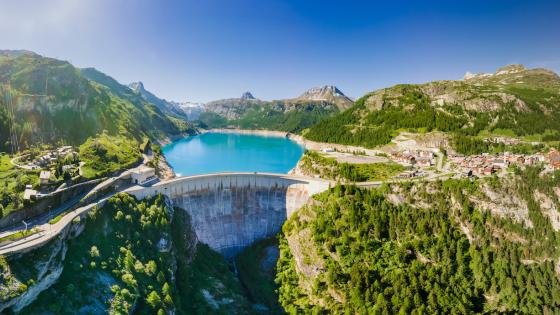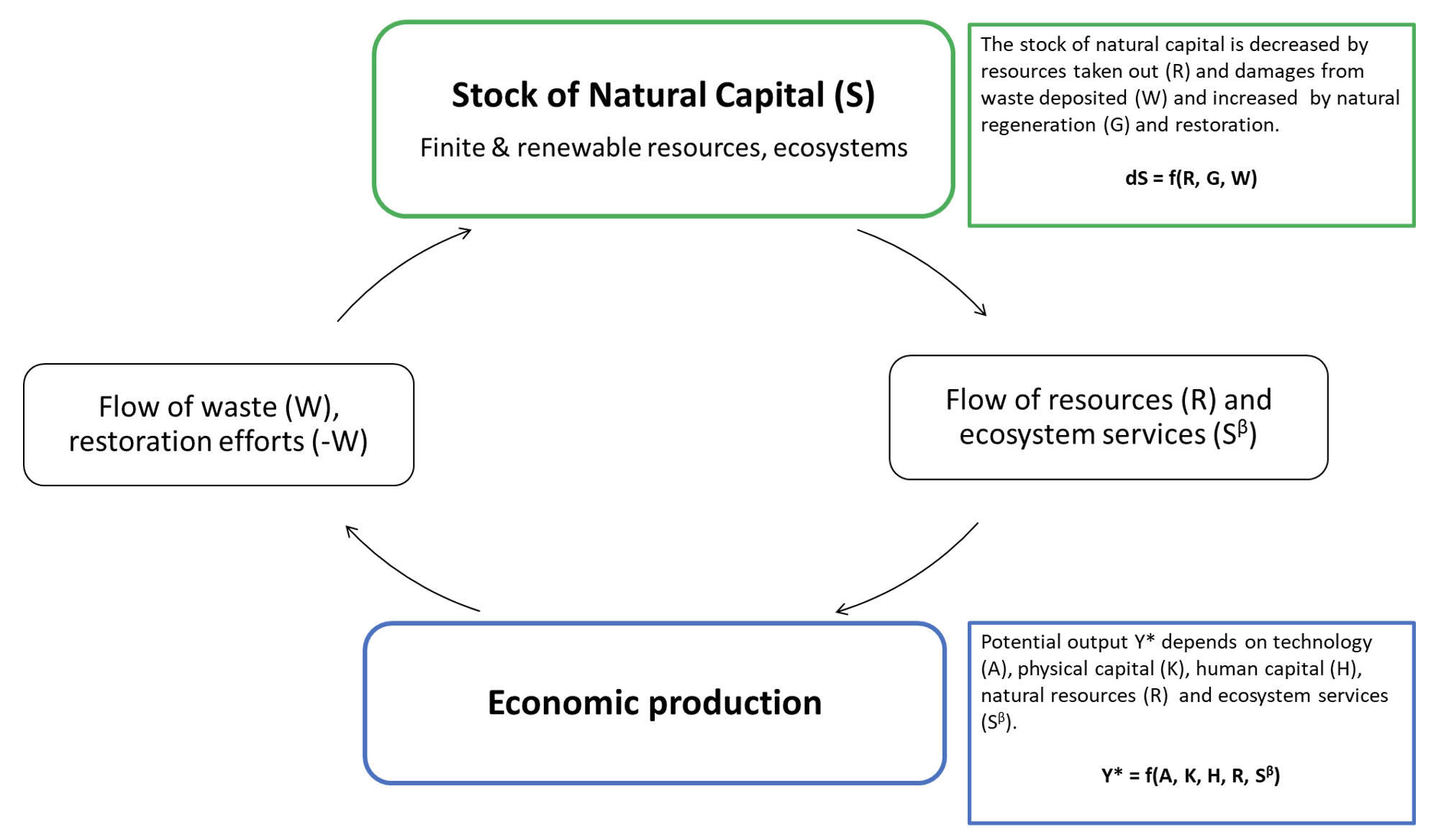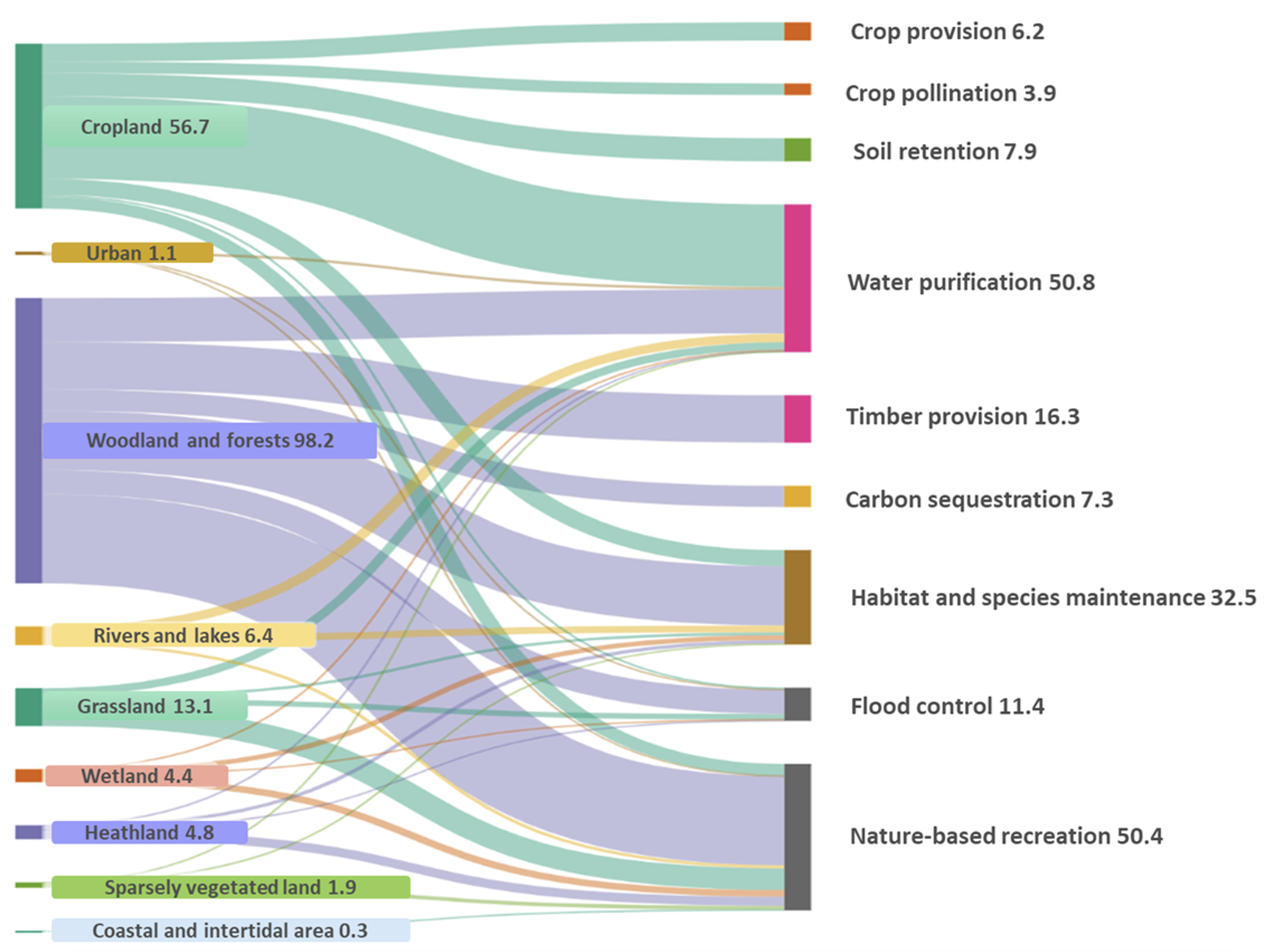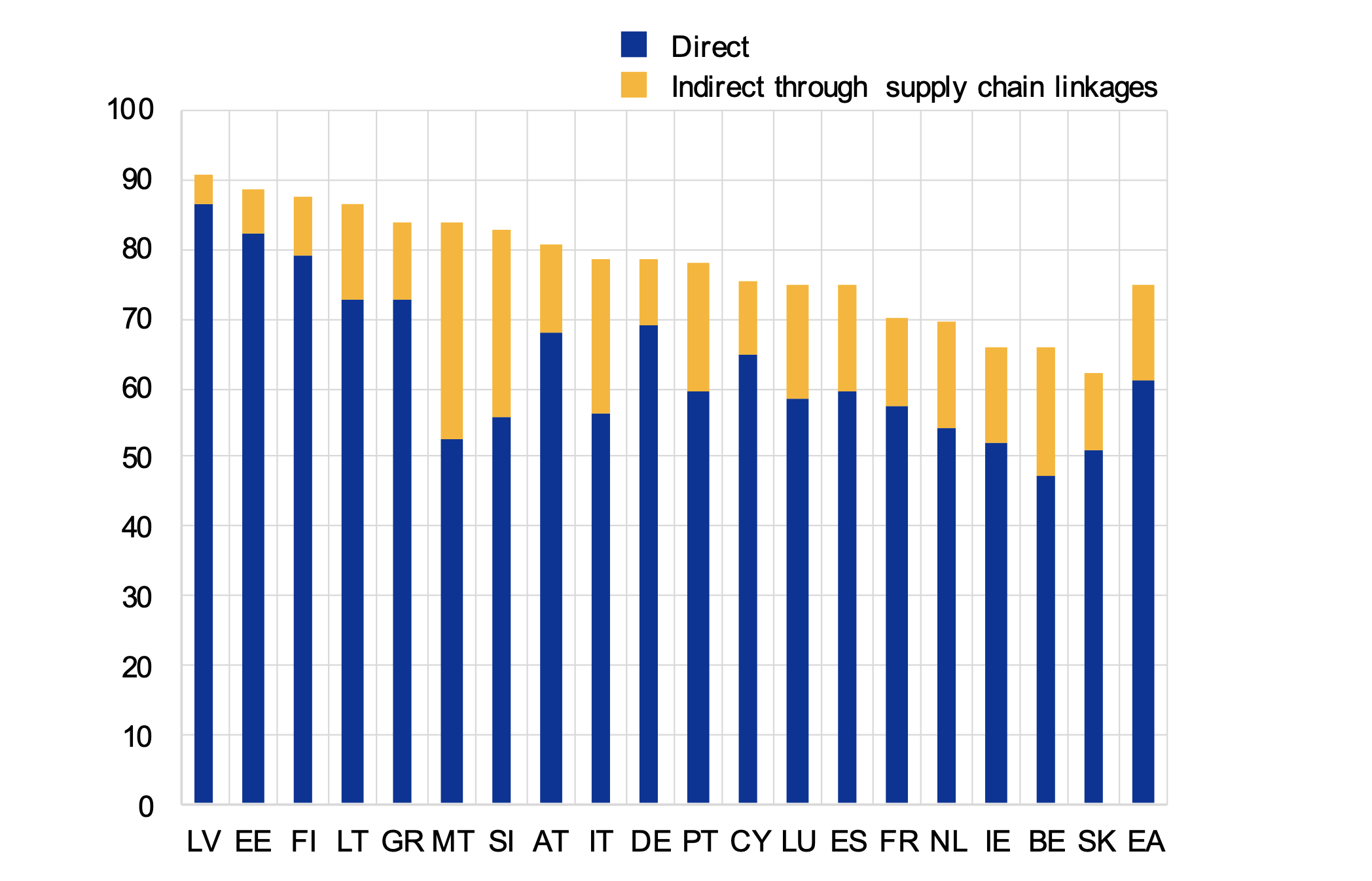“Is GDP growth compatible with sustainable development? The question can be answered only within the context of complete macroeconomic models of the long run, in which natural capital plays an essential role…” (Dasgupta 2021).
Figure 1 Feedback loops between natural capital and the economic production system
Source: European Commission, adaptation from Dasgupta (2021), Chapter 4*
The contribution of nature to economic activity is only partly reflected in traditional measures of economic output and standard macroeconomic models. This column summarises a recent workshop on “Natural Capital Measurement and Modelling” jointly organised by DG Economic and Financial Affairs, the Joint Research Centre of the European Commission, and the Output Gap Working Group of the EU’s Economic Policy Committee. The workshop discussed the measurement of natural capital,
modelling the dependence of the economy on natural inputs, and possible policy implications.
Can natural capital be measured and is it already visible in traditional data?
Many natural assets sit at the boundaries of,
or outside, the national accounts and are thus invisible in standard metrics of economic production. However, Arturo de la Fuente (Eurostat) explained that Eurostat collects environmental and ecosystem data in physical modules (e.g. material flows) and monetary modules (e.g. environmental taxes and subsidies). These Environmental Economic Accounts are based on an internationally agreed methodology that establishes a link to the national accounts through shared concepts and input-output tables. Marialuisa Tamborra, Ioanna Grammatikopoulou, and Alessandra La Notte (Joint Research Centre) explained the measurement of the extent and condition of ecosystems and the flow of services
they provide (Figure 2). Where the socioeconomic demand on these services persistently exceeds supply capacity, ecosystems become vulnerable.
Figure 2 Ecosystem services in the EU-27 (billion euros, 2018)
Source: Joint Research Centre. Notes: Nine ecosystem services out of 90 currently listed by CICES. Crop provision only reflects the ecosystem contribution (without human input) and does not double count pollination and soil retention. Water purification includes the nitrogen retention in inland waters and in soil. Nature-based recreation and habitat and species maintenance are services directly to end users. No further economic transformations (implying value added) take place. Hence, nature-based recreation excludes tourism and is here computed as the daily recreation mainly undertaken by residents.
Modelling ecosystem services necessitates spatial and sectoral granularity (La Notte et al. 2022). While the EU is internationally a frontrunner in the development of environmental economic accounts, it still only captures a fraction of natural capital.
Beyond GDP: Wealth accounting and green net domestic product
The sustainability of economic activity can be assessed by observing changes in the stock of natural capital alongside GDP. Stefanie Onder (World Bank) provided insights into the forthcoming Changing Wealth of Nations report, which assesses an extended set of finite and renewable natural assets. The data cover 11 types of natural assets, are aligned with the System of Environmental Economic Accounts, and are comparable across a large set of countries and over time. A key finding is that, per-capita, renewable natural capital is being depleted at an unsustainable rate.
Edward Barbier (Colorado State University) suggested taking the dynamics of natural capital into account in adjusted net domestic product (ANDP) (Barbier 2019), i.e. GDP net of the depreciation of fixed capital as well as net gains or losses in natural (relating to resources), ecological (relating to ecosystems), and human capital (Figure 3). As an indicator of sustainability, adjusted net domestic product allows to assess whether the reduction of the stock of natural/ecological capital is compensated for by the accumulation of fixed or human capital.
Figure 3 From GDP to green net domestic product (NDP)
Source: European Commission, adapted from Barbier (2019)
Simply extending the production function captures flows but not stocks of natural capital
Marta Kornafel (Krakow University of Economics) explored the possibility of sustainable growth in a simple Solow growth model extended with natural capital (Kornafel and Telega 2020). This model implies that sustainable growth (by which a positive stock of natural capital is maintained) is only possible if natural capital is actively maintained through investment, which implies slower accumulation of fixed capital.
The long-run impact of climate change, extreme weather, and the transition to the net-zero carbon economy are likely to affect the components of potential output, namely fixed capital, labour, and total factor productivity. Miles Parker (ECB) stressed that the impact goes well beyond the destruction of physical capital from extreme weather events and includes effects on both labour supply and technological progress (Parker 2023).
For a quantitative approximation of the contribution of natural capital to economic output, Miguel Cárdenas Rodríguez (OECD) used a standard production function extended with natural capital. Focusing on how productivity may be affected by natural capital, he provided a measure of environmentally adjusted multifactor productivity (Cárdenas Rodríguez et al. 2018, 2023). According to this measure, the contribution of natural assets is relatively small in countries that do not rely much on extractive industries.
The picture is however different when one looks at country vulnerabilities linked to natural capital disruption. Working with firm-level data, Andrej Ceglar (ECB) highlighted the dependence of euro area firms on ecosystem services and the potential for nature-related risks spilling over from non-financial companies to the financial sector (Boldrini et al. 2023, Figure 4). Large economic impacts could result from the cascading effects of the degradation of natural capital and climate change.
Figure 4 Share of loans to companies with a high dependency on at least one ecosystem service (euro area, percentages, December 2021)
Source: Boldrini et al. (2023)
Making feedback loops explicit: Earth-economy modelling
A more complete modelling approach consists of covering the full feedback loop from the impact of economic activity on natural capital and the depletion of the latter on economic possibilities (cf. Figure 1). Frances Moore (UC Davis) presented a standard climate integrated assessment model, extended with natural capital (Bastien-Olvera and Moore 2021). Though stylised, it highlights the impact on the economy both directly from climate change and via the damage rising temperatures cause to natural capital. Moore also advocated combining climate models with (structural) macroeconomic models to take the economic effects of climate mitigation policies and the physical damage caused by climate change explicitly into account in medium-term projections of potential output.
Justin Johnson (University of Minnesota) presented a detailed model of the interlinkages between the Earth’s environmental system and the economy where land use, environmental conditions, ecosystem services, and economic output are jointly determined (Johnson et al. 2023). The economy module is a version of the computable general equilibrium model GTAP.
This is combined with a global, spatially explicit, environmental model (InVEST). The combined integrated assessment model can be used to assess marginal policy interventions such as defining nature conservation areas or for assessing the impact of ecosystem collapse when biophysical tipping points are crossed.
Sustainable management of natural assets and fiscal prudence
Further research on the effects of the depletion of natural capital on potential output and the related feedback loops is needed. Collecting more complete data on natural capital and improving the modelling will take time. However, it is unlikely that a single tool will prove sufficient; it is much more probable that a suite of models will evolve for handling different policy questions.
In the interim, policymakers must work with the insights that are already available. Existing measures of natural wealth and green net domestic product (NDP) can complement GDP and allow for an assessment of the sustainability of economic production. Green investments to mitigate the depletion of natural capital are crucial to avoid potentially large economic effects, which could become catastrophic once tipping points or cascading impacts are triggered. In addition, economic damage that can no longer be avoided will weigh on future potential output and thereby constrain the leeway for managing debt/GDP ratios through the denominator. One of the tasks for future fiscal policy consists of prioritising investment in environmental sustainability whilst maintaining debt on a fiscally sustainable path. The economic and political economy challenge is formidable, but failure to act swiftly will only have a compounding effect.
References
Barbier, E B (2019), “The concept of natural capital”, Oxford Review of Economic Policy 35(1): 14-36.
Bastien-Olvera, B and F Moore (2021), “Use and non-use value of nature and the social cost of carbon”, Nature Sustainability 4: 101-108.
Boldrini, S, A Ceglar, C Lelli, L Parisi and I Heemskerk (2023), “Living in a world of disappearing nature: physical risk and the implications for financial stability”, ECB Occasional Paper 333.
Cárdenas Rodríguez, M, I Haščič and M Souchier (2018), “Environmentally Adjusted Multifactor Productivity: Methodology and Empirical Results for OECD and G20 Countries”, OECD Green Growth Papers No. 2018/02.
Cárdenas Rodríguez, M, F Mante, I Haščič and A Rojas Lleras (2023), “Environmentally adjusted multifactor productivity: Accounting for renewable natural resources and ecosystem services”, OECD Green Growth Papers No. 2023-01.
Council of Economic Advisers and Office of Management and Budget (2023), “Methodologies and Considerations for Integrating the Physical and Transition Risks of Climate Change into Macroeconomic Forecasting for the President’s Budget”, White Paper, Washington D.C.
Dasgupta, P (2021), The Economics of Biodiversity: The Dasgupta Review, London: HM Treasury.
Döhring, B, A Hristov, A Thum-Thysen and C Carvello (2023), “Reflections on the Role of Natural Capital for Economic Activity”, European Economy Discussion Paper 180.
Johnson, J A, U Lantz Baldos, E Corong, T Hertel, S Polasky, R Cervigni, T Roxburgh, G Ruta, C Salemi and S Thakrar (2023), “Investing in nature can improve equity and economic returns”, Proceedings of the National Academy of Sciences of the United States of America 120(27) e2220401120.
Kornafel, M and I Telega (2020), “Dynamics of natural capital in neoclassical growth model”, International Journal of Sustainable Economy 12(1).
La Notte, A, I Grammatikopoulou, M Zurbaran Nucci, A Marques, S Ferrini, S Cerilli and M Tamborra (2022), Linking accounts for ecosystem Services and Benefits to the Economy Through bridging (LISBETH) Part II, Publications Office of the European Union, Luxembourg, doi:10.2760/827473, JRC130438.
Parker, M (2023), “How climate change affects potential output”, ECB Economic Bulletin 6/2023.
United Nations (2014), System of Environmental-Economic Accounting 2012, Central Framework, New York.
United Nations (2020), Natural Capital Accounting For Sustainable Macroeconomic Strategies, Department of Economic and Social Affairs, New York.
United Nations (2021), System of Environmental-Economic Accounting – Ecosystem Accounting (SEEA EA), New York.












